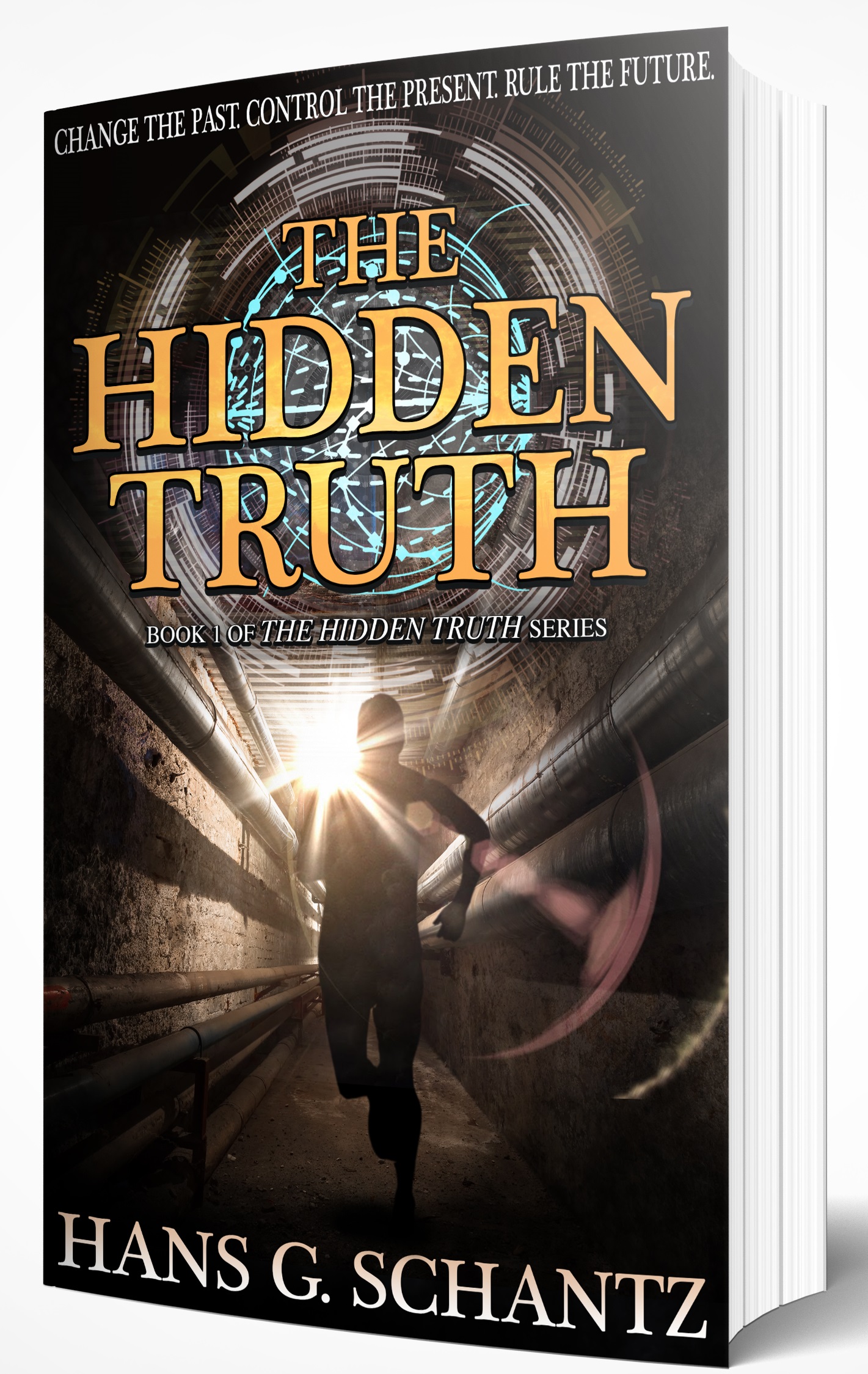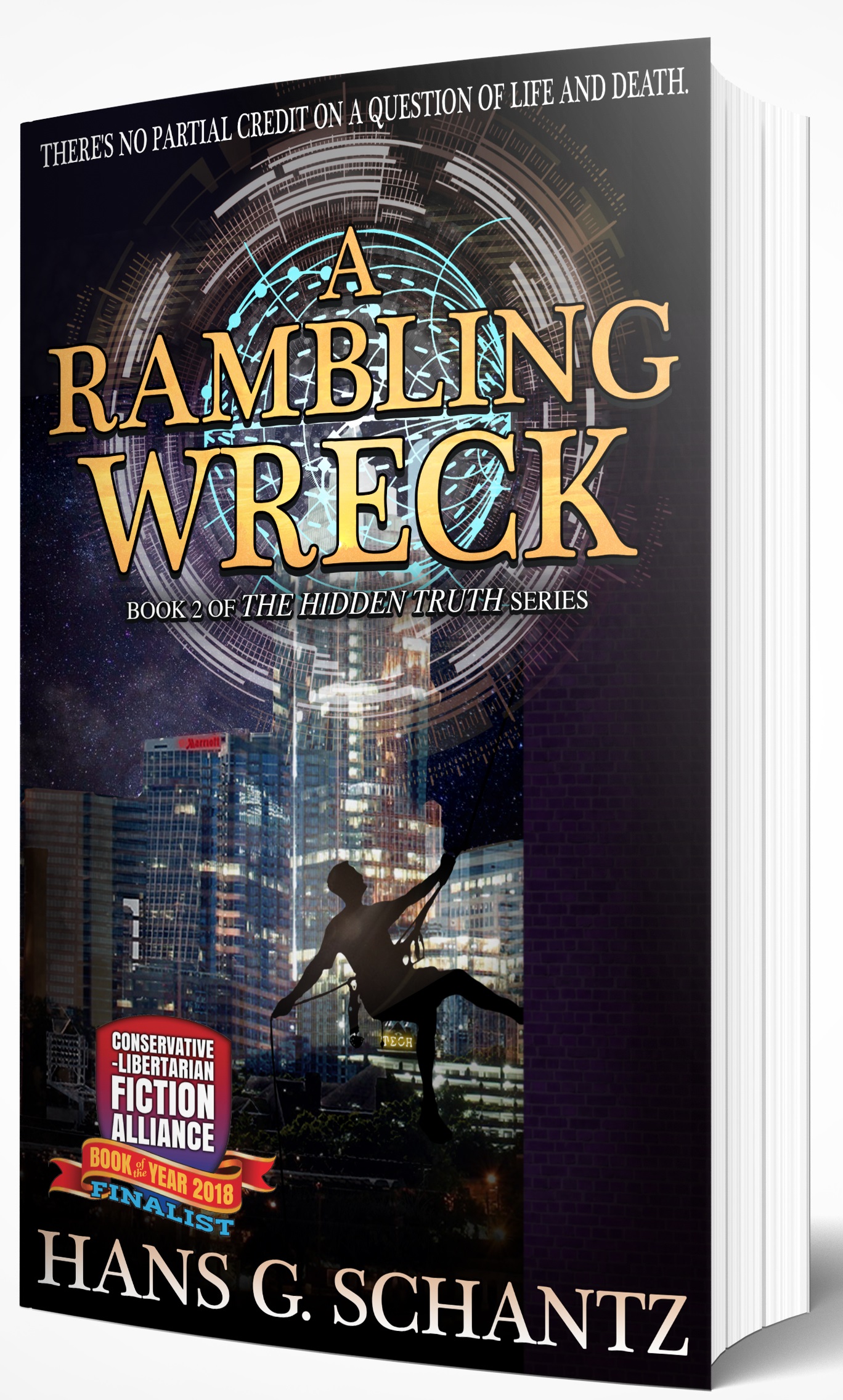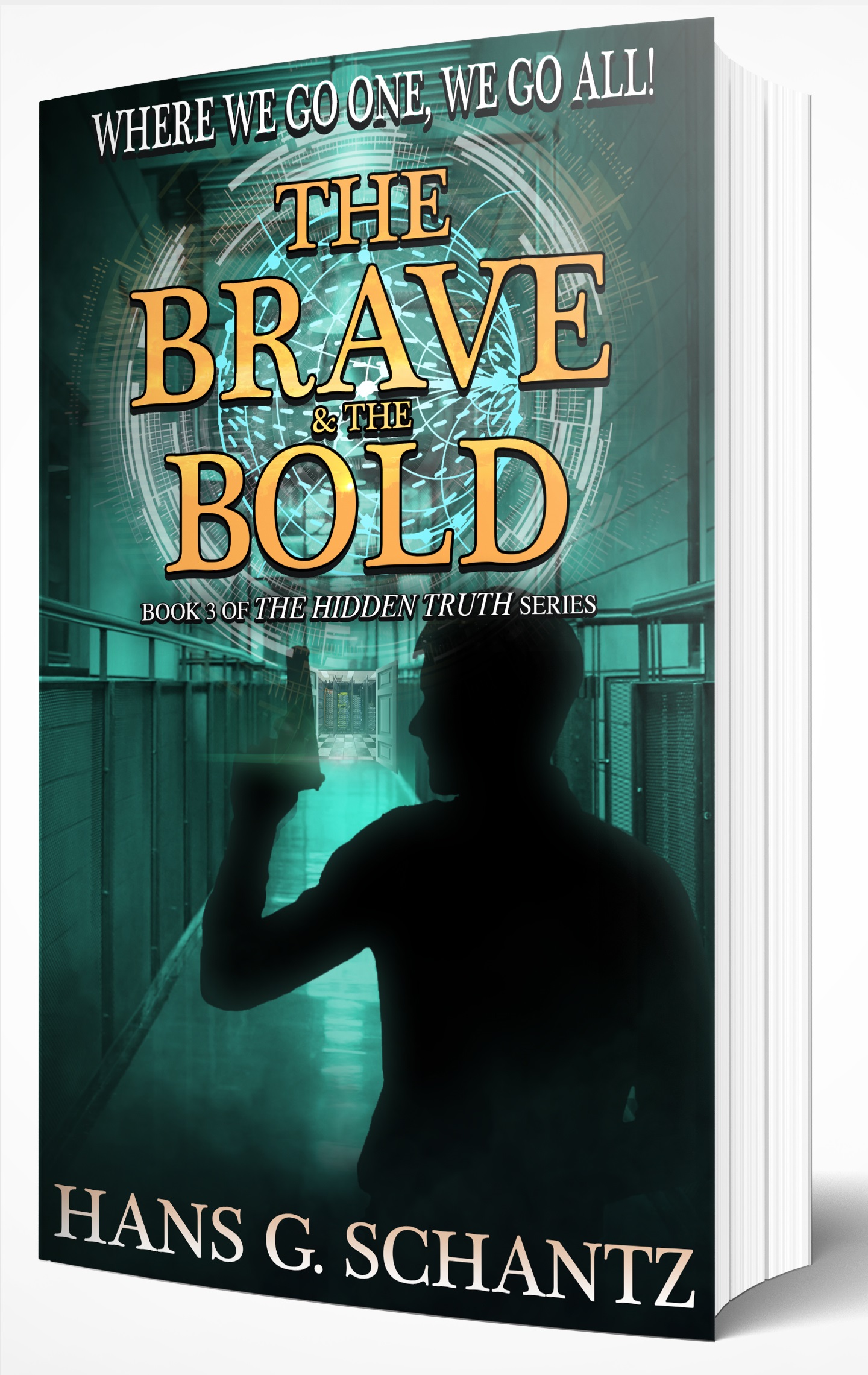The Hidden Truth by Hans G. Schantz
In honor of the biggest and best Labor Day booksale of all timespace, I thought it proper to repeat, complete and expand upon my review of the Hans G. Schantz Hidden Truth triology.
Hans G. Schantz’ THE HIDDEN TRUTH is most highly recommended.
It is a gem of a book, a rare find, combining a charming coming of age story, diamond-hard science fiction speculation, a conspiracy thriller, a touch of trenchant political commentary, and, uniquely, a challenge written into a science fiction book of the reigning scientific orthodoxy of the day.
Rarely are science fiction stories written by credentialed scientists. Even more rare is one that proposes a revolutionary theory that questions the historical and theoretical roots of the standard model of modern physics, and no other book does so in the context of an action thriller.

This is a world nextdoor to our own, one where Al Gore won the 2000 election, and the 9/11 attack struck the White House, and the internet is under direct federal control.
High school student Peter Burdell of rural Tennessee, while preparing for his debate club contest and learning how to flirt with girls, discovers an odd discrepancy in an electronics paper from the days of Maxwell and Heaviside, which points to the existence of an entire branch of electromagnetic phenomena apparently never investigated — but after the murder of an innocent bystander, Peter realizes that the knowledge exists, and has been ruthlessly suppressed.
The ability of the conspirators to monitor and edit their world’s version of the internet, and to track down all physical copies of the forbidden books being kept from the public, is backed by corrupt federal agents, and is portrayed in an all too believable way. Anyone who knows or even suspect the scope of the massive gaslighting frauds maintained to this day by all major media and Deep State actors acting in concert will not have difficulty maintaining suspension of disbelief.
With the help of his self-reliant father, pistol-packing mother, and computer nerd friend Amit Patel, some home-made ham radio gear, and plenty of healthy paranoia, Peter steps into a dangerous funhouse mirror labyrinth of falsehoods, feints, arsonists and assassins, frame ups and cover ups, where choosing whom to trust is a life-or-death gamble.
And when the conspirators become aware of Peter’s investigation, disaster strikes.
If you liked Heinlein style juveniles, with their young men learning lessons about personal responsibility and integrity of character, and seasoned with brief avuncular lectures on topics ranging from electromagnetic theory to economic reality, then you are likely to enjoy this book.
The characters are warm and likable, the alternate history is too close to our own for comfort, the family feuds and the petty ambitions and government corruptions described are all too real. This is the tale of a young man who learns, too late, what evil will do to hide the truth.
Let this book warn this generation of the dangers of our day; deep state corruption, fake news, public school political indoctrination, and the panopticon surveillance state; just as George Orwell’s Nineteen Eighty-Four was warned his generation of the dangers of socialism and political correctness in his day.

In A RAMBLING WRECK Peter makes overtures to his mother’s wealthy family. They are well connected — very well connected — with powerful social and political movers and shakers both of their rural county and on the national scene. But when she married his father, an ornery, brilliant, old-fashioned self-made man from the wrong side of the tracks, she was disowned.
Now that he is going to college, however, the aid of the well-connected family would be welcome, and the family also has plans to bring young Mr. Burdell into the fold, and to make some use of him.
The family, however, has ties to a group of philanthropic & progressive organizations called the Inner Circle, who are not only behind the dirty secrets of more than one political scandal and socialist conspiracy, but is one and the same with the ancient conspiracy — who knows how old? — that is manipulating the scientific community and hiding a dark secret about the nature of electromagnetism and timespace.
At the school, Peter discovers and infiltrates the Inner Circle efforts to bring political correctness into the university, and turn the physics department into one more little Ministry of Truth spreading indoctrination, not education.
Infiltration, as it turns out, involves insulting and wounding people and causes one supports. The young man learns that being a double agent means earning the despite and mistrust of everyone.
The self-righteous hypocrisy, the half-insane zeal, the elliptical language and cold wickedness of the students and their cynical adult handlers is portrayed with a disquieting realism that cuts too close to home. The self-contradictory philosophy of social justice is not being parodied here: the author takes every line from some real statement made by their counterparts in the real world. The author here not only portrays with truthful pen, but trenchantly gives the tactics and techniques commonly used in our world by such unscrupulous creatures.
But Peter Burdell also discovers a darker secret: satellite data is pinpointing bursts of radioactivity on the surface of the earth which correlates with data Peter has collected about the secret conspiracy, and the technology only they control.
Or is it only they?
Complications ensure when hints of a second conspiracy, as old and well funded as the first, and as ruthless, is also working behind the scenes of history… a Chinese Tong, once in service to the conspiracy, now opposing …. a secret order within the Dominicans, who, like the monks in the Middle Ages protecting ancient learning from being lost, seek to protect the hidden modern sciences, preserving them against the day when the conspiracy must fail…
Again, Peter must thread his way between trust and treason, and learn that seeming foes might be friends, or seeming friends are foes.
To add to his woes, Peter has girl troubles, both with vexatious “Me-Too” coeds willing to throw life-ruining accusations hither and yon with heedless abandon, with sensuous undergrads working on term papers, and with one honest-to-goodness Oriental femme fatale.
The fact that his friend Amit Patel is full of cynical advice on the theory and practice of the scientific art of seduction does not help matters.
And one of these women may be the next target for assassination by the Inner Circle, for venturing too close to the Forbidden Theory – and Peter has to save life of a young lady who has no real reason to trust him, somehow without revealing his true loyalties and motives to her nor to the conspirators who have at least one agent in the school faculty.

THE BRAVE AND THE BOLD brings the story arc, but not the series, to a conclusion, as the Inner Circle arranges a meeting of their members to discuss involving the United States in a useless, endless low-level military conflict, as prelude to darker, deeper designs. The opportunity to frame a high-ranking member of the conspiracy, and to thwart the designs, is boldly seized upon by Peter and his various allies in this unseen war. Hints of even deeper layers come to the fore, in a climactic gun battle on Jekyll Isle, with someone who may well be the source of the urban legend and penny-dreadful character Spring-heeled Jack, if not someone more ancient and dangerous.
This trilogy works on several levels. In style, theme, in social commentary, in genre, in plot-weaving and world-building, the craftsmanship is top-notch.
Stylistically, it is written in the same journalistic prose as a Heinlein juvenile, but, frankly, is better. Not only are some of Heinlein’s more dubious moral lessons absent, the work attempts something more ambitious: introducing a real theory of physics in the midst of a fictional adventure yarn.
Thematically, it is a bracing and inspiring coming-of-age story telling young readers and reminding older readers what it means to be a man, a man of integrity, in a world where no one is there to dig you out of a mess.
It works as social commentary. As in a Heinlein juvenile, there are memorable quips and trenchant observations about political realities peppered throughout the dialog, which have as much application in our world as theirs.
Two examples will suffice:
“Real socialism has never been tried,” Abby asserted. “Those were unsuccessful and flawed attempts.”
“Would you say the Aztecs never practiced real human sacrifice,” Dad asked dryly, “because they never did get their crops to grow reliably no matter how much blood they shed?”
A thought I wished I could have put so well! Second example:
“It’s profoundly ironic,” he observed with obvious amusement. “A strong, independent woman is now one who meekly obeys the media’s and society’s clamor to be a career girl and sleep around with whatever stud catches her fancy or with other girls, for that matter. A woman with the courage to defy that social pressure and devote herself from a young age to building a home and raising a family is an aberration, a weirdo, a traitor to her sex. There aren’t many women with the balls to stand up against that kind of social pressure. It’s not in their nature.”
Well said.
The story works as a conspiracy theory tecno-thriller, hitting all the right notes without getting too over-the-top.
In particular, the look at political infighting on college campuses, and the glimpse of media manipulation and mass-propaganda in the second and third volumes are chilling, and chillingly accurate. The fictional conspiracy in the work is based on a studied understanding of how such real world conspiracies operate.
There is even a trenchant insight on how a lazy professor might grade a math test, and then accuse any student bright enough to figure out the trick of cheating. It sounds realistic enough!
By its very nature, any thriller story has to walk a highwire between two opposite claims on the reader’s suspension of disbelief. On the one hand, the hero has to be in a danger he himself must face. On the other hand, there is no drama if the conspiracy is so large and deep as to be omnipotent.
In other words, there has to be a reason why the hero does not call the police, who call in the national guard, who call in the marines, who call in the science patrol, or whatever. Here the idea of a conspiracy is useful: one cannot turn to the police if the police cannot be trusted, either because they are corrupted or have been deceived. One cannot go to the press, if the press is also in on it.
At the same time, the conspiracy that controls police and press must be afraid of someone or something, or else they would be out in the open.
In this case, the secret technology of the conspiracy allows them to hone in our the activities of the hero, but the conspiracy can never come into the open. Indeed, they can never allow even the smallest hint of their secret to be suspected, since it is based on a scientific theory one hundred years old, one which any scientist of sufficient skill and imagination could independently discover.
Now, the author is greatly aided by this being a science fiction story taking place in a world parallel to ours. Things that would strain the suspension of disbelief if proposed seriously in our world, seem all too likely in a world where Al Gore and his ilk were in uninterrupted charge of the government for a decade.
An alternate history story is convincing or unconvincing based on the integrity of the worldbuilding, on little details that follow from the deviation event severing it from our world.
In this case, the deviation is based on a presence of an Illuminati group which is not present (one hopes) in our world, and the social and political changes issuing from the 9/11 terror attack only slightly more successful than the one in our world. The presence or absence of one man, or one “let’s roll” decision by that man, makes all the difference.
The worldbuilding here is top-notch, indeed, to the point where, more than once, I had to look up a historical event mentioned in the text, to see whether it had actually happened in this world or not. To my surprise, it was always the less believable events that actually happened here, including longstanding historical injustices.
Famed physicists Maxwell, Hertz, and Fitzgerald all died in their prime of life, before completing their life’s work. Heaviside claimed certain people were harassing him, forcing him to live in solitude. Oliver Lodge dropped the study of physics in favor of parapsychological research. All these things are true. None were mentioned in any history book I ever read.
A science fiction, this book is unique. It proposes a real theory of physics challenging to the fundamental assumptions underpinning quantum mechanics.
What if a much simpler theory underlying electromagnetic behavior were true?
What if not just one or two aspects, but the whole structure of non-linear thinking, effects preceding cause, clouds of probability, Schrodinger’s cat being simultaneously alive and dead, reality being unfixed until observed, all the paradoxes and mind-boggling dreamlike irrationalism of modern physics were unjustified? What if there were a more elegant explanation, one fitting all the known observations, but not reared in defiance of common sense or common logic?
What if there were a hidden truth?
While this seems absurd on its face, one need only look at the intellectual history of some other discipline, let us say, economics, or climatology, to see how political or philosophical bias among the intellectual class could prop up, for generations, theories that defy common sense, which history later reveals to have been humbug from the beginning.
How many highly intelligent and learned men, for example, have been deceived by Marxist claims that one can run an economy without an economy, by fiat; or Keynesian claims that a nation can borrow its way out of debt, by going further into debt?
How many climate scientists take as gospel a theory that undetectable changes in atmospheric composition can lead to a runaway greenhouse effect — based on not a scintilla of real-world evidence?
Is there something that makes electromagnetic particle physics and the mortal men who study it somehow immune from bias, from conformity, and from collective human error?
Because we are not talking about an experimental error one researcher might make which, in theory, another might correct. By definition, no empirical test can verify or deny that unobserved particles exist as semi-unreal clouds of probability rather than as physical entities with persistent physical properties. The unobserved by definition is not observed, hence not open to empirical observation.
Rather, we are talking about a philosophical argument about the metaphysical underpinnings of the physical sciences, that is, whether or not unobserved particles exist, or whether observation can cause changes in ontological state from probable to actual.
Physicists have no more authority or training to address philosophical questions than economists have to address theological questions.
In a science fiction story, questions can be raised that might be too uncomfortable to confront if raised in real life. But such questions may start the wheels of speculation turning, especially in younger thinkers with no reputation to lose when the next revolution in science descends upon the world with the thunder of a landslide, as theories thought to be as firm as mountains uproot and shift their bases.
It would be an event dearly to be wished if this trilogy were the dislodged pebble that starts that landslide.
Be warned that the tale is not complete.
Rumor has it that the author, Hans G. Schantz, is hard at work on the final volume, A HELL OF AN ENGINEER, but a hefty amount of public interest, and some book sales of the first three in the series, might stoke the fires under this boiler, and give him the spirit needed to complete the work in a reasonable time.
